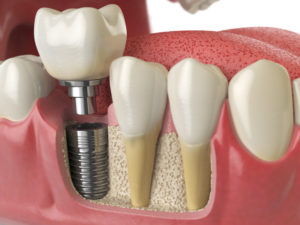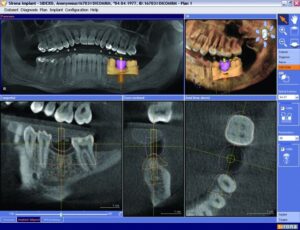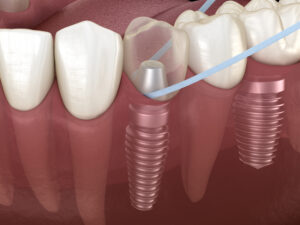Tips for Dental Implant Success
 When you invest in a dental implant or implants to replace missing teeth, you are investing in an improved appearance, better support for your chewing and speaking abilities, and an overall improved quality of life. Dental implants have a very high success rate when you properly care for them. This article will highlight some of the most important factors in achieving long-term success with your dental implants. We have divided these important factors into the stages of surgery, healing, and long-term maintenance.
When you invest in a dental implant or implants to replace missing teeth, you are investing in an improved appearance, better support for your chewing and speaking abilities, and an overall improved quality of life. Dental implants have a very high success rate when you properly care for them. This article will highlight some of the most important factors in achieving long-term success with your dental implants. We have divided these important factors into the stages of surgery, healing, and long-term maintenance.
Planning and Surgery: Choosing the Right Implant Dentist
The first step in implant success is choosing the right implant dentist. The reason this is so important is that there are specific criteria regarding the placement of the dental implant that factor in to its success. An experienced implant dentist understands these principles and factors in any foreseeable complications to the long-term success.
Dr. Ann Haggard has been successfully placing dental implants for more than fifteen years. She undergoes continuing education every year to ensure that she is always at the top of her implant game. Designer Smiles utilizes the highest level of advanced technology in our pre-operative implant planning and implant placement protocols.
 We incorporate three-dimensional imaging that provides precise measurements necessary to plan where the implant will go. We do not rely on the 3D technology to do the work for us. Instead, Dr. Ann combines the information from the 3D image with her knowledge and experience to plan the exact dimensions and positioning of each patient’s dental implant.
We incorporate three-dimensional imaging that provides precise measurements necessary to plan where the implant will go. We do not rely on the 3D technology to do the work for us. Instead, Dr. Ann combines the information from the 3D image with her knowledge and experience to plan the exact dimensions and positioning of each patient’s dental implant.
We also use a sophisticated “GPS” during the actual implant placement called X-Nav. This technology guides the implant placement surgery to within a tenth of a millimeter, and it incorporates the planned positioning from the 3D image and Dr. Ann’s pre-op planning.
When implants are predictable, they have the highest long-term success rate. We make them predictable through our education, experience, and advanced technology.
Short-term Healing: No Smoking
Once you have a dental implant placed by your experienced implant dentist using the latest technology, you must follow the post-operative instructions to ensure proper healing. For success in the short-term just following the implant placement surgery, one of the most important things you can do is NOT smoke.
The first few months following implant surgery are the time period in which the jawbone grows into and attaches to the implant root form. This is a process we call osseointegration. Without osseointegration, the implant will fail. For good osseointegration to occur, the bone must have a great blood supply. This is where smoking comes in.
When you smoke (or use nicotine of any kind), it constricts or shrinks the tiny blood vessels in the extremities of the body. (This is the same reason that smoker’s often suffer from progressive gum disease.). Without adequate blood flow to the site of surgery, the bone is less likely to heal and attach to the implant.
Smokers have a much higher rate of dental implant failure than non-smokers. The constriction on the blood flow is proportional to the amount of nicotine you use. People who smoke two packs a day will have a higher risk for implant failure than a casual user who only smokes a few cigarettes on the weekend.
You can minimize this risk for failure by NOT smoking for a week or more before your implant placement surgery and the first month afterward.
Long-term Maintenance: Great Oral Hygiene
Once a dental implant is in place and the bone has firmly attached to it, you enter the long-term maintenance phase. A dental implant has the wonderful advantage of being incapable of getting a cavity! Bacteria cannot penetrate the titanium structure of a dental implant, so cavities are not a risk.
 Bacteria can attach to the dental implant in the form of dental plaque and cause gum disease, though. Gum disease, when left untreated, destroys the bone and gum attachment to both teeth and dental implants. When gum disease causes attachment loss on a tooth, we call it periodontitis. When it affects dental implants, we call it peri-implantitis.
Bacteria can attach to the dental implant in the form of dental plaque and cause gum disease, though. Gum disease, when left untreated, destroys the bone and gum attachment to both teeth and dental implants. When gum disease causes attachment loss on a tooth, we call it periodontitis. When it affects dental implants, we call it peri-implantitis.
The disease process is the same for both categories. It begins with the accumulation of dental plaque. Bacteria within the sticky plaque buildup produce toxins that penetrate into the surrounding gum and bone. Your body responds to those toxins with inflammation. Acute inflammation is good, because it causes swelling, bleeding, and tenderness. It tells you there is a problem. Unfortunately, acute inflammation transitions into chronic inflammation when the cause of the inflammation remains present. Chronic inflammation is destructive in nature. It breaks the attachment of the bone and gums to the tooth or implant. This loss of attachment can lead to dental implant failure.
How Can You Do Your Part in Long-Term Maintenance?
Great oral hygiene around a dental implant is essential to protect its attachment to the bone and gums. You can prevent peri-implantitis by consistently removing dental plaque, just as you prevent periodontal disease by removing plaque from the teeth. This must include brushing and flossing the implant, just like natural teeth. In cases of dental implants, they often have larger spaces between the teeth or between the implant crown and the gum tissues. This area can accumulate plaque and food debris, so in addition to brushing and flossing, you might need to incorporate the use of tiny interdental brushes. These extra tools look like tiny pipe cleaners with a handle that can quickly and easily clean any open spaces. We love GUM’s Soft Picks for this job. They come in a small case you can keep in your pocket or purse for use after every meal.
More Questions about Dental Implant Success?
Call Designer Smiles to schedule a consultation with Dr. Ann. She can answer any questions you have about dental implants and make personal recommendations based on your unique situation.
